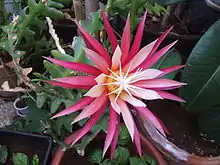Selenicereus anthonyanus
Selenicereus anthonyanus (also known by its obsolete name, Cryptocereus anthonyanus) is a cactus species native to southern Mexico. It is grown as an ornamental because of its nocturnal flowers and unusual, leaf-like stems. Common names include fishbone cactus, rick rack cactus, zig-zag cactus and St. Anthony's rik-rak, and is sometimes referred to as an orchid cactus.
| Fish bone cactus | |
|---|---|
 | |
| Photo: Floriano Calcagnile | |
| Scientific classification | |
| Kingdom: | Plantae |
| Clade: | Tracheophytes |
| Clade: | Angiosperms |
| Clade: | Eudicots |
| Order: | Caryophyllales |
| Family: | Cactaceae |
| Subfamily: | Cactoideae |
| Genus: | Selenicereus |
| Species: | S. anthonyanus |
| Binomial name | |
| Selenicereus anthonyanus (Alexander) D. Hunt | |
| Synonyms | |
|
| |

History
This species is named after Harold E. Anthony who first flowered this species in June 1950. The former generic name Cryptocereus (literally, "hidden cereus") recalls the fact that the species remained long unknown in a region that had been thoroughly investigated by Thomas MacDougall, who found this species in 1946. He thought he had found a close relative to Epiphyllum anguliger. When it flowered in the greenhouses of Dr. Harold E. Anthony in Jersey in 1950 it was obvious that this was a great novelty. The species is rarely collected and most plants in cultivation descend from this first collection.
Description
The stems of the plant are ascending or climbing. Its branches are in clusters at intervals along the stem, to 1 m long or more, 7–15 cm wide, flat with few aerial roots; the lobes are 25–45 mm long and 10–16 mm wide, somewhat tapered towards the rounded apex; areoles are small; epidermis is green to yellowish green, smooth. The edges are deeply lobed.
The fragrant flowers are 10 to 12 centimeters long and 15 to 17 centimeters in diameter. The outer bracts are purple and spread out until they are bent back. The inner bracts are ascending, cream-colored and yellow towards the flower throat. The seed vessel is 15–20 mm long and green in color. The pericarpel is covered with numerous small scales with gray wool, bristles and thorns.
The fruits are round or oval and up to 6 cm. They are full of thorny areolae, which drop off as they mature. Seeds are 2 x 1.5 mm, black in color.
Origin and habitat
S. anthonyanus is endemic to moist lowland rainforest of southern Mexico, in the states of Chiapas, Oaxaca, Tabasco and Veracruz growing at altitudes of 180 metres (590 ft) to 500 metres (1,600 ft).[1]
Systematics
This is an isolated species with no close allies. Selenicereus chrysocardium seems to be the closest relative. Two other epiphytic cacti from other genera show similar strongly notched flat stems and which, when not in flower, are not readily distinguishable from this species: these are Epiphyllum anguliger and Weberocereus imitans.
Cultivation
An easily cultivated, fast growing epiphyte, S. anthonyanus needs a compost containing plenty of humus and sufficient moisture in summer. Should not be kept under 4 °C (39 °F) in winter. Can be grown in semi–shade or full sun. Extra light in the early spring will stimulate budding. Flowers only open for one night and are very fragrant, as to attract nocturnal pollinators. Flowers in late spring or early summer.
Hybrids
- 'Corinna Paetz' (S. anthonyanus × 'Feuerauber')
- ×Disoselenicereus 'Stauch's Mandarin' by Dr. Stauch (Disocactus × smithii × S. anthonyanus)
- ×Disoselenicereus 'Noris' by R. Gräser (Disocactus speciosus × S. anthonyanus).
- ×Disoselenicereus 'Wormatia' by Dr. Stauch (Disocactus × smithii × S. anthonyanus).
- ×Disoselenicereus 'Müllers Mandarin' ('Stauch's Mandarin' × Disocactus speciosus)
References
- Terrazas, T., Arreola, H., Ishiki, M. & Pizaña, J. 2013. Selenicereus anthonyanus. The IUCN Red List of Threatened Species 2013: e.T152753A674371. https://dx.doi.org/10.2305/IUCN.UK.2013-1.RLTS.T152753A674371.en. Downloaded on 01 February 2017.